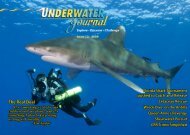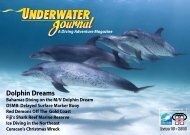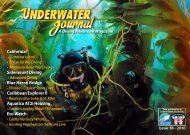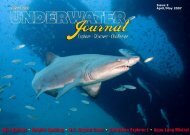- REBREATHERS - SPORT DIVERS ... - Stingray Divers
- REBREATHERS - SPORT DIVERS ... - Stingray Divers
- REBREATHERS - SPORT DIVERS ... - Stingray Divers
You also want an ePaper? Increase the reach of your titles
YUMPU automatically turns print PDFs into web optimized ePapers that Google loves.
make maintaining a specific depth impossible.<br />
On the upside, it is a magnet to passing pelagics.<br />
Especially sharks.<br />
This trip I was determined to photograph the<br />
Wall of Hammerheads, should I see it again.<br />
Luckily, perhaps, my resolve wasn’t tested.<br />
During the four dives I made on the Rock this<br />
trip, I saw lots of sharks, at least five different<br />
species. And though schools of hammerheads<br />
were always present they were way below us, at<br />
the edge of visibility.<br />
Whitetip reefs, on the other hand, were easy to<br />
photograph. They were always found lying about in the<br />
same shallow depressions on one side of the Rock.<br />
Schools of bigeye jacks large<br />
enough to blot out the sun<br />
are a common occurence in<br />
the Socorro Islands.<br />
Five large Galapagos sharks had a certain<br />
rocky promontory they liked to circle. On one<br />
occasion we rounded a corner and came face<br />
to face with them. The sharks recovered first<br />
and moved to shallower water. In addition to<br />
this regular cast of characters, there were also<br />
appearances by silky and silvertip sharks.<br />
While we didn’t see a whale shark at Roca<br />
Partida, divers on the trip before ours did. We<br />
also didn’t see humpback whales underwater,<br />
though there was plenty of activity on the<br />
surface, typically just before sunset. That’s<br />
when the city bus sized giants seemed to rouse<br />
from their slumbers and begin blowing and<br />
The Socorro islands<br />
(islas revillagigedo)<br />
Comprised of only four islands,<br />
this covers 320 square miles. The<br />
northernmost of this small archipelago<br />
is San Benedicto, a sleeping volcano<br />
(2.6 miles across), 180 miles southwest<br />
of Cabo San Lucas. Socorro (Spanish<br />
for “help”), the largest (10 miles long,<br />
9 miles wide), is 40 miles south of<br />
San Benedicto. Roca Partida (300 feet<br />
long, 115 feet tall) is 60 miles west<br />
of Socorro. The fourth major island,<br />
Clarion, is 250 miles west of Socorro<br />
and is rarely, if ever, visited by dive liveaboards<br />
today.<br />
Above water, the islands are home to<br />
birds and other endemic and introduced<br />
species; humans live only at the Mexican<br />
naval bases on Socorro and Clarion.<br />
The Mexican government declared the<br />
islands a Biosphere Reserve in June<br />
1994 and banned fishing within 12 miles<br />
of land. According to Wikipedia.com,<br />
the islands were named after Don Juan<br />
Vicente de Guemes Padilla Horcasitas<br />
y Aguayo, 2nd Count of Revillagigedo,<br />
the 53rd viceroy of New Spain.<br />
Long known for their friendly manta<br />
rays, the Socorro’s are also the winter<br />
calving and mating grounds for<br />
humpback whales, which make the long<br />
journey here from Alaska and the U.S.<br />
West Coast.<br />
www.underwaterjournal.com June/July 2007






